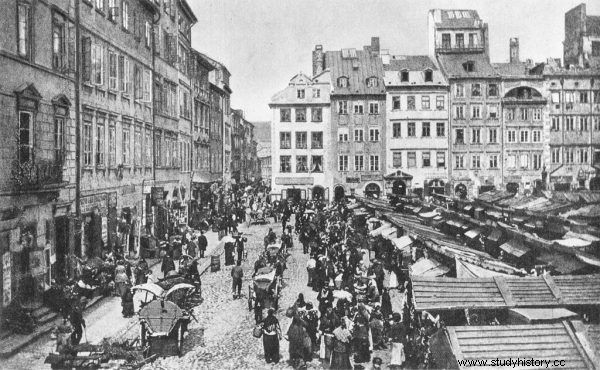What were the penalties in the past for aborting a fetus to a woman, and what to a doctor? Who was forced to have an abortion, and who was categorically forbidden? What methods were used and what were their consequences? The debate about whether and how pregnancy can be terminated has been going on for centuries. And it has aroused emotions for centuries.
As always, all TOP10 items are based on the articles we publish. This time we decided to show what our ancestors thought about abortion. You can find more historical controversies HERE .
10. At the end of the 19th century, doctors from Warsaw who performed abortions were sent to Siberia

In nineteenth-century Warsaw, little was said and written about abortion. However, there were severe penalties for performing the procedure, both for the woman who terminated the pregnancy and for the doctor (source:public domain).
In modern times in Poland, abortion was subject to the same penalty as for infanticide:death. Only the first penal code in Poland, announced in Congress Poland in 1818, introduced "more modern" solutions. According to them, first of all, a woman who committed an artificial miscarriage was punished. Penalties for doctors were tightened gradually. Already in the second half of the 19th century, the procedure was subject to 4 to 6 years of hard labor, i.e. deportation to Siberia (read more on this topic).
9. In modern Iran, abortion may be the only way for a woman to survive

In Iran, abortion laws were tightened after the overthrow of the Shah Reza Pahlavi regime and the arrival of the Islamic Republic of Iran in 1979, in the wake of the revolution led by Ayatollah Ruhollah Khomeini (source:public domain).
Many countries also now have strict anti-abortion laws. A total ban on termination of pregnancy was introduced, among others, in El Salvador and Chile. Against this background, Iranian legislation looks liberal. The 2005 law allows women to have an abortion in two cases:if it is necessary to save their health and life, or if there is a serious defect in the fetus. The penalties for illegal surgery, however, are drastic. Yes, and the penalties for "illegal" pregnancy. A woman who is expecting a child out of wedlock is in mortal danger. And this is on the part of my own family (read more about this).
8. Prostitutes were forced to have abortions in ancient Rome

Comfortable conditions in a Pompeian brothel (photo:János Korom Dr., CC BY-SA 2.0).
The alternative to the surgery was ... infanticide. Archaeologists sometimes find traces of this practice, such as during excavations under the so-called Yewden Villa in Hambleden, Buckingham County, where a mass grave with the remains of about a hundred newborns was found (read more on this).
7. In communist Romania, only women who had already had four children had the right to abortion (and contraception)

"There is no place in Romania for women who are not mothers!" - thundered from Ceauşescu's rostrum to his party comrades and companions (source:Institutul de Investigare a Crimelor Comunismului în România).
Nicolae Ceauşescu dreamed of Romania, with a population of twenty-five million in 2000. To achieve his goal, he drastically curtailed women's right to abortion and the availability of contraception. The new regulations were introduced by Decree No. 770 of October 1, 1966. According to him, the right to contraception and abortion was granted only to those women who fulfilled the patriotic duty and gave birth to at least four children (in 1984 this number increased to five). There is no place in Romania for a woman who is not a mother - Ceauşescu argued (read more on that).
6. The ancient Greeks believed that abortions were the specialty of women midwives

The Greeks forbade women to practice medicine. To become a doctor, Agnodike, a young Athena, disguised herself as a man. However, she soon had to reveal her true gender. Painting by Jean-Léon Gérôme from 1861 (source:public domain).
Already the pioneer of medicine, Hippocrates, who lived in the 5th century BCE, banned women from entering his school on the island of Kos. However, he allowed them to learn obstetrics in Asia Minor. After his death, the Greeks forbade all ladies from medical practice under the penalty of killing them. The reason was precisely the recognition that pregnant women will report to doctors with a request for surgery (read more on this topic).
5. The punishment of abortion in pre-war Warsaw led to an escalation of the practice of abandoning newborns

In the interwar period, abortion was punishable. A measurable effect of this regulation was the increase in the number of abandoned newborns. Not all abandoned children were lucky enough to end up in one of the capital's shelters (source:public domain).
Paradoxically, some children have benefited from being abandoned. If they were lucky enough to end up in one of the orphans' shelters offering shelter, food and even education. The city was devoured by another. They may even have fallen victim to the human traffickers (read more on this).
4. In the People's Republic of Poland, abortion was available on request. And homosexuality was treated with electroconvulsive therapy

In the People's Republic of Poland, abortion was legal. However, the polls were illegal, because "there is no man there, there is only ass". Such as this Japanese vending machine for magazines and movies for adults was like the forbidden fruit (photo:Daniel Axelson - Flickr, license CC BY-SA 2.0).
Abortion on request, unlimited access to contraceptives ... It is easy to believe that the People's Poland in the field of sex was a mainstay of uncontrolled progress. But not all Poles had the right to exercise moral liberties. Even homosexuality was perceived in the times of the People's Republic of Poland as a sexual perversion and a disease. It was believed that those affected by this "disorder" could be treated with electroconvulsive therapy. It was common practice (read more about it).
3. In the 17th century, pharmacists terminated pregnancy. Or witches

Laurel, today used mainly as a spice, was one of the most popular miscarriage and menstrual plants in the 17th century. In a miniature of a herbarium by Georg Andreas Helwing from the early 18th century, we can see Daphne transforming into a laurel tree (source:National Library, public domain).
One method of abortion in the 17th century was bloodletting to induce menstruation . But there were also magical practices (for example, wearing amulets) or macabre methods known from the Middle Ages. For example, a woman placed testicles cut off from a live weasel and wrapped with donkey skin on her belly (read more about it).
2. In the USSR, it was easier to terminate a pregnancy than to protect against it

Seeking help "from my grandmother" could have ended tragically for a woman. Soviet poster from 1925 informing about the dangers of abortion (public domain).
Abortion was legal for most of the Soviet Union's existence. Russia was the first country in the world to legalize abortion. It is estimated that up to 280 million surgeries were performed in the Soviet Union. The shocking statistics were mainly the result of ... a shortage of contraceptives. The level of sexual education for both women and men was also low (read more on this topic).
1. According to doctors' estimates, in the Second Polish Republic, from a few to 50% of abortions ended in the woman's death.

In such conditions, illegal abortions were carried out in the 1930s overseas. They were usually even worse on the Vistula (source:public domain).
Abortion was illegal in pre-war Poland, and the punishment for performing the procedure was punishable by both the woman and the doctor. So the "scratch" was most often performed by bastards and fraudsters, with dirty tools, without any control and without responsibility. The effects were predictable. The eminent specialist in the field of forensics, Wiktor Grzywa-Dąbrowski, recalled that he was the only one:"dissecting up to two hundred corpses of women who died [after spending the fetus] of blood poisoning [annually], and this is only a fraction" (read more on this topic).
